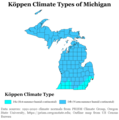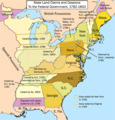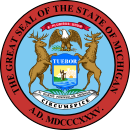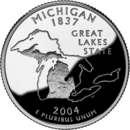Portal:Michigan
The Michigan Portal  Michigan (/ˈmɪʃɪɡən/ ⓘ MISH-ig-ən) is a state in the Great Lakes region of the Upper Midwestern United States. It borders Wisconsin to the northwest in the Upper Peninsula, and Indiana and Ohio to the south in the Lower Peninsula; it is also connected by Lakes Superior, Michigan, Huron, and Erie to Minnesota and Illinois, and the Canadian province of Ontario. With a population of nearly 10.12 million and an area of 96,716 sq mi (250,490 km2), Michigan is the 10th-largest state by population, the 11th-largest by area, and the largest by area east of the Mississippi River. Its capital is Lansing, and its largest city is Detroit. Metro Detroit is among the nation's most populous and largest metropolitan economies. The name derives from a gallicized variant of the original Ojibwe word ᒥᓯᑲᒥ (mishigami), meaning "large water" or "large lake". Michigan consists of two peninsulas. The Lower Peninsula resembles the shape of a mitten, and comprises a majority of the state's land area. The Upper Peninsula (often called "the U.P.") is separated from the Lower Peninsula by the Straits of Mackinac, a five-mile (8 km) channel that joins Lake Huron to Lake Michigan. The Mackinac Bridge connects the peninsulas. Michigan has the longest freshwater coastline of any political subdivision in the United States, being bordered by four of the five Great Lakes and Lake St. Clair. It also has 64,980 inland lakes and ponds. Michigan has the second-most water area of any state, behind only Alaska. The area was first occupied by a succession of Native American tribes over thousands of years. In the 17th century, French explorers claimed it as part of the New France colony, when it was largely inhabited by indigenous peoples. French and Canadian traders and settlers, Métis, and others migrated to the area, settling largely along the waterways. After France's defeat in the French and Indian War in 1762, the region came under British rule. Britain ceded the territory to the newly independent United States after its defeat in the American Revolutionary War. The area was part of the larger Northwest Territory until 1800, when western Michigan became part of the Indiana Territory. Michigan Territory was formed in 1805, but some of the northern border with Canada was not agreed upon until after the War of 1812. Michigan was admitted into the Union in 1837 as the 26th state, a free one. It soon became an important center of industry and trade in the Great Lakes region, attracting immigrants in the late 19th and early 20th centuries from many European countries. Immigrants from Finland, Macedonia, and the Netherlands were especially numerous. Migration from Appalachia and of Black Southerners as part of the Great Migration increased in the 1930s, with many settling in Metro Detroit. (Full article...) Entries here consist of Good and Featured articles, which meet a core set of high editorial standards.
The Ford Piquette Avenue Plant is a former factory located within the Milwaukee Junction area of Detroit, Michigan, in the United States. Built in 1904, it was the second center of automobile production for the Ford Motor Company, after the Ford Mack Avenue Plant. At the Piquette Avenue Plant, the company created and first produced the Ford Model T, the car credited with initiating the mass use of automobiles in the United States. Prior to the Model T, several other car models were assembled at the factory. Early experiments using a moving assembly line to make cars were also conducted there. It was also the first factory where more than 100 cars were assembled in one day. While it was headquartered at the Piquette Avenue Plant, Ford Motor Company became the biggest U.S.-based automaker, and it would remain so until the mid-1920s. The factory was used by the company until 1910, when its car production activity was relocated to the new, bigger Highland Park Ford Plant. Studebaker bought the factory in 1911, using it to assemble cars until 1933. The building was sold in 1936, going through a series of owners for the rest of the 20th century before becoming a museum in 2001. The Piquette Avenue Plant is the oldest purpose-built automotive factory building open to the public. The museum, which was visited by over 31,000 people in 2018, has exhibits that primarily focus on the beginning of the United States automotive industry. The building was added to the National Register of Historic Places in 2002, became a Michigan State Historic Site in 2003, and was designated a National Historic Landmark in 2006. (Full article...)Selected picture - The Highland Park Ford Plant was a production plant for Ford Motor Company in the city of Highland Park, Michigan, which is surrounded by Detroit. The Highland Park Ford Plant was designed by Albert Kahn in 1908 and was opened in 1910. Did you know -
Related portalsSelected article - Presque Isle County (/ˈprɛskiːl/ PRESK-eel) is a county in the Lower Peninsula of the U.S. state of Michigan. As of the 2020 census, the population was 12,982. The county seat is Rogers City. The county was authorized by state legislative action on April 1, 1840, but the county government was not established until 1871. The government was reorganized in 1875. The name is an anglicisation of the French word presqu'île or presque-isle, which means a peninsula, or literally, "almost an island". A large part of Presque Isle Township consists of that peninsula, with Lake Huron on the east, Grand Lake on the west, and narrow strips of land connecting it to the mainland at the north and south ends. The community of Presque Isle is near the center of this peninsula. (Full article...)Selected biography -Brandon Ricardo Minor (born July 24, 1988) is a former American football running back. He played college football at Michigan from 2006 to 2009. He was signed by the Chicago Bears as an undrafted free agent in 2010, but was released during the final cuts and played on practice squads in 2010 for the New Orleans Saints and Indianapolis Colts. At Michigan, Minor finished second on the team in rushing both as a freshman and sophomore and led the team in rushing both as a junior and senior. As a junior, he was an honorable mention All-Big Ten Conference selection by the coaches. He had previously been ranked as the number one high school football fullback in the nation, according to Rivals.com. (Full article...)General imagesThe following are images from various Michigan-related articles on Wikipedia.
TopicsCategoriesSymbols
Lists
Related pagesWikimediaThe following Wikimedia Foundation sister projects provide more on this subject:
Things you can doDiscover Wikipedia using portals | ||||||||||||||||||||||||||||||||||||










































































